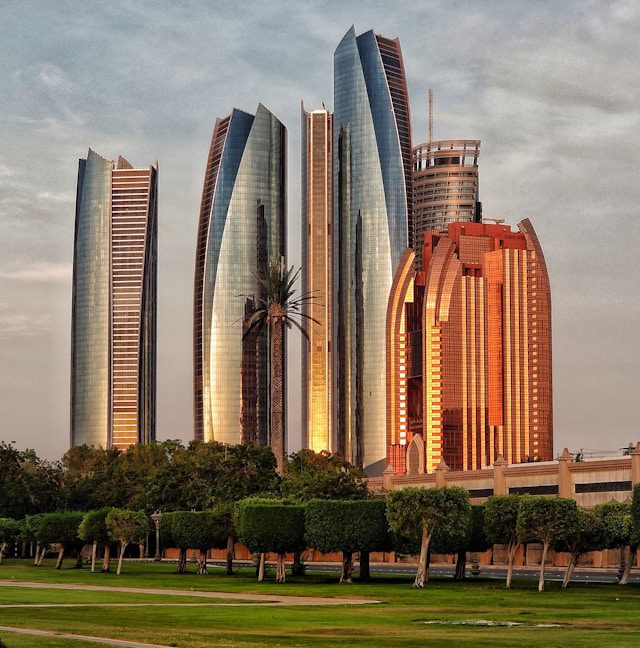Abu Dhabi is the capital city of the United Arab Emirates where contemporary urban life is combined with age-old traditions, creating a wide array of experiences for travelers. The once solitary fishing village has turned into a lively metropolis due to the riches acquired from oil. Abu Dhabi tourist attractions include old sites like Qasr Al Hosn and modern marvels like Ferrari World and Yas Marina Circuit.
A large part of Abu Dhabi is off the Persian Gulf coast and connected to the mainland by a narrow bridge, the city occupies most of a small triangle island by the same name. Originally a small village of limited local significance, Abu Dhabi grew into a modern city with a fully built infrastructure thanks to the emirate’s oil earnings.
Over the past ten years, the UAE has become the Middle Eastern tourism destination of choice for international visitors. Recent figures show that the UAE, especially Abu Dhabi, has drawn the most proportion of visitors to different Arab countries. Thanks to Abu Dhabi tourist attractions, family travel has especially grown really remarkable. These include first-rate recreational activities and services, top-notch facilities for many kinds of guests and all ages, and world-class conveniences.
What Elements Make Abu Dhabi The Middle Eastern Travel Destination Of Choice?
There are several compelling reasons why Abu Dhabi has become the place to go for many travelers. For one, it has a rich cultural heritage as evidenced by Qasr Al Hosn and Sheikh Zayed Grand Mosque that have deep connections to local history as well as religious significance in general. It is this combination of ancient traditions mixed up with modernity which make it a unique cultural center where tourists can enjoy the best of both worlds.
In addition, some of the world’s most breathtaking buildings are located in this city. The Sheikh Zayed Grand Mosque is one such structure that will leave you speechless; there are numerous futuristic skyscrapers along Corniche including Etihad Towers among others. The skyline serves as an affirmation of what they can do architecturally. It is a sight to behold, with untold cultural connections created by combining cutting-edge designs and traditional Arabian aesthetics.
When it comes to luxury, Abu Dhabi tourist attractions are second to none. Visitors can enjoy luxury shopping at The Galleria, stay at famous hotels such as Emirates Palace or eat fine dining cuisine in world-class restaurants. If they want more excitement perhaps dune bashing trips, camel rides or sand skiing can be arranged for them too.

For tourists, safety and advanced infrastructure are also major Abu Dhabi tourist attractions. What is more, Abu Dhabi is safe due to its low crime rates, high-quality transportation systems, comfortable hotels and healthcare facilities that ensure people feel secure. The food diversity in the city embodies the multicultural essence as it offers numerous international dishes as well as traditional Emirati meals that cater for every taste.
Abu Dhabi is famous for its cordiality and hospitable disposition. For this reason, it has several visa categories including tourist visas on entry which makes it accessible even for overseas visitors who want to tour the place. Consequently, this city stands out from others as a perfect travel destination because of its rich culture; luxurious lifestyles, breathtaking sceneries coupled with easy accessibility thus making it appealing to different travelers globally.
Major Cultural Abu Dhabi Tourist Attractions
1. Qasr Al Hosn
Known sometimes as the White Fort, Qasr Al Hosn is Abu Dhabi’s oldest stone construction. The ruling family, the seat of government, a consultative council, and a national archive have all found home here. 2018 saw it transformed into a museum exhibiting a wide range of objects, pictures, and archive materials going back 6000 BC.
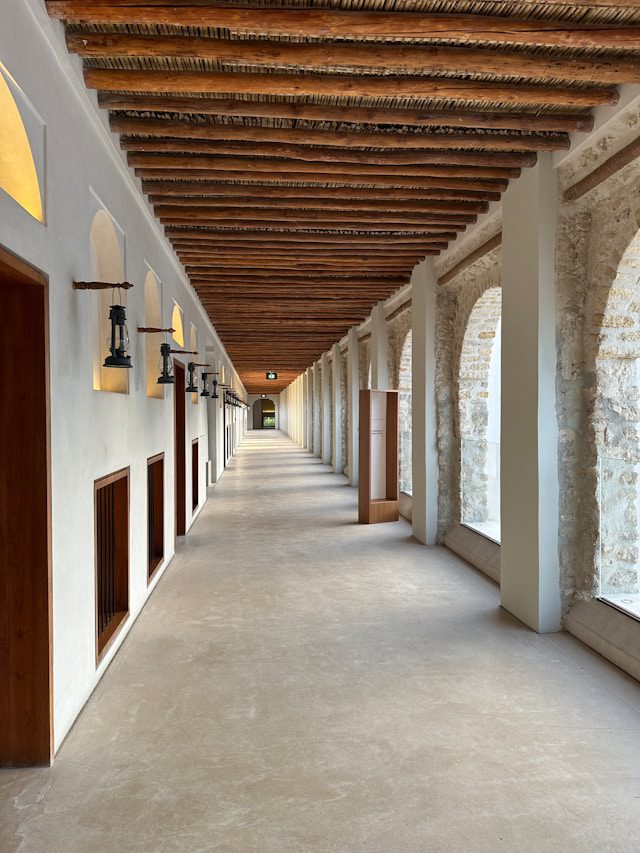
The building houses many crafts and talents that the Emirati people have created to satisfy both financial and practical demands over years. See as artisans weave date palm leaves together in a technique known as khoos, construct complex designs using al-sadu (a type of Bedouin weaving) and produce delicate needlework known as talli.
2. Grand Mosque built by Sheikh Zayed
Certainly the most well-known site in Abu Dhabi, Sheikh Zayed Grand Mosque is a must-see! One of the most remarkable places of worship in the world, only finished in 2007, it can comfortably accommodate more than 40,000 worshippers. Inspired by a great variety of religious sites around the world, from the Abu al-Abbas al-Mursi Mosque in Alexandria to the Badshahi Mosque in Lahore, Pakistan, its design included a jaw-dropping 82 domes, 24 carat-gold gilded chandeliers, and over 1,000 columns covered in amethyst and jasper.
Entrance is open to everyone from 9am to 10pm, Saturday through Thursday. Entering is free; guided tours are also offered.
3. Quasr Al Watan
Opening in 2017, Qasr Al Watan is among Abu Dhabi’s most recent cultural icons. Comprising the formal offices of the President and the Crown Prince of Abu Dhabi, the Presidential Palace of the UAE, The Great Hall features mirrored cubes, curved glass panels, Arabesque patterns and symmetric marble panels. This building houses the centuries-old Atlas astronomy manuscript, the first modern and accurate map of the Arabian Peninsula from 1561, and Pliny’s Natural History encyclopaedia.
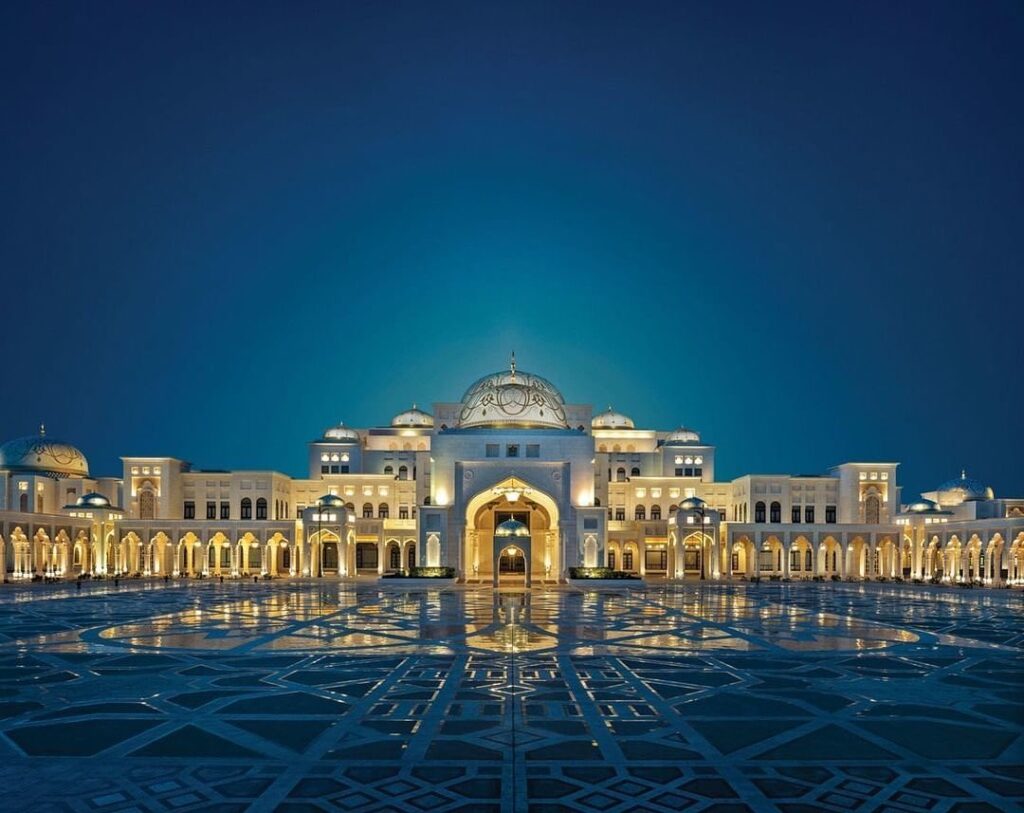
Either go explore the gardens or arrange a 90-minute tour of this magnificent structure. Additionally in the evenings is the “Palace in Motion,” when a light and sound display is projected onto the structure.
4. Al Ain
Al Ain is worth the extra travel east of Abu Dhabi, near the Oman border. One hour thirty-minute journey It’s a real desert oasis, all palm palms and natural springs; not surprising that it’s sometimes called the Green City then. Along with the 5,000-year-old Jebel Hafit Tombs, Al Jahili is one of the biggest forts in the UAE and among the oldest permanently inhabited towns in the world, a UNESCO World Heritage Site as well.
If you have walking boots with you hike up here for amazing views, Jebel Hafit is also the highest point in Abu Dhabi. Alternatively, it’s been said that this is among the best driving routes in the world.
The fort is a classic example of traditional Emirati architecture, built mainly of sun-dried mud bricks. This construction material, extensively utilized within the area, was chosen due to its capacity for natural insulation against the harsh desert heat. Al Jahili Fort has been a symbol of the region’s resilience for centuries but it went through large-scale restoration during 2007 and 2008.
This restoration project was very carefully done to conserve its original form and pattern for posterity while ensuring that it lasts long enough for coming generations. To strengthen walls and towers made out of mudbrick modern techniques were applied as opposed to keeping the authentic appearance with such traditional materials and methods that had long been used in other places of the world like ours where such structures remain unaltered time after time without collapse or decay whatsoever over years or decades at times even extending upto centuries , sometimes losing some parts due natural disasters.
Al Jahili Fort represents more than just an architectural wonder; it stands as symbolise UAE’s culture and heritage. The fort is a living proof of Sheikh Zayed bin Khalifa’s wise leadership and foresight who played an instrumental role in its construction. It also represents the close bond between Al Ain citizens and their soil which indicates how much they relied on agriculture as well as water management for survival in arid regions.
5. Quasr Al Hosn
See this stone fort in the middle of Abu Dhabi to be reminded of when the city was hardly more than a fishing town. Built around a tower constructed in the 1790s to guard a valuable water source for what was then a developing pearling town, Qasr Al Hosn boasts magnificent views over the coastal trade routes and housed the Al Nahyan family, emirate ruler for almost two centuries.
Following a ten-year rehabilitation, it opened as a museum in 2018 and currently features a superb collection of objects spanning thousands of years.

6. Manarat al Saadiyat
Manarat al Saadiyat, translating to “Place of Enlightenment,” is a cultural center located on Saadiyat Island purposely built for artistic dialogue and cultural exchange. Within the facility are exhibitions, workshops as well as film screenings focusing on contemporary art and culture. This art center has numerous gallery spaces that showcase both local and international artists’ works offering a platform for artistic expression.
Other activities include hands-on experiences in an art studio or simply visiting the center’s café and boutique. Manarat Al Saadiyat is an important part of Abu Dhabi’s ambition to become a worldwide cultural destination. Its design mirrors its goal of promoting enlightenment and fostering creativity.“ The sleek modernistic architecture includes very large galleries capable of hosting diverse forms of cultural events.” Through its arrangement, you can glide through exhibitions, workshops or experience some interactivity thus facilitating a vibrant atmosphere that allows everyone access to art and culture.
Must-See Architectural Masterpieces In Abu Dhabi
1. Al Bahr Towers
Known for their pineapple-like exteriors, these twin office buildings on Sheikh Zayed Bin Sultan Street have come to be an icon in Abu Dhabi. Inspired by traditional mashrabiya, the geometric Teflon-coated mesh structure covering the green structures reacts automatically to the sun, therefore providing shade for the interiors and lowering power use.
Each tower has a height of 145 meters and encompasses 25 stories of office space. The two buildings have their exteriors composed of a sleepy honeycomb structure made up of 2000 elements which moves according to sun’s intensity. Sun path monitors are used by sophisticated computer systems for controlling this adaptive shading plant by means of which it changes its face, in this way optimal shadows arise during the day while natural light penetrates interior spaces creating bright working environments that lead to less usage of electric lights.
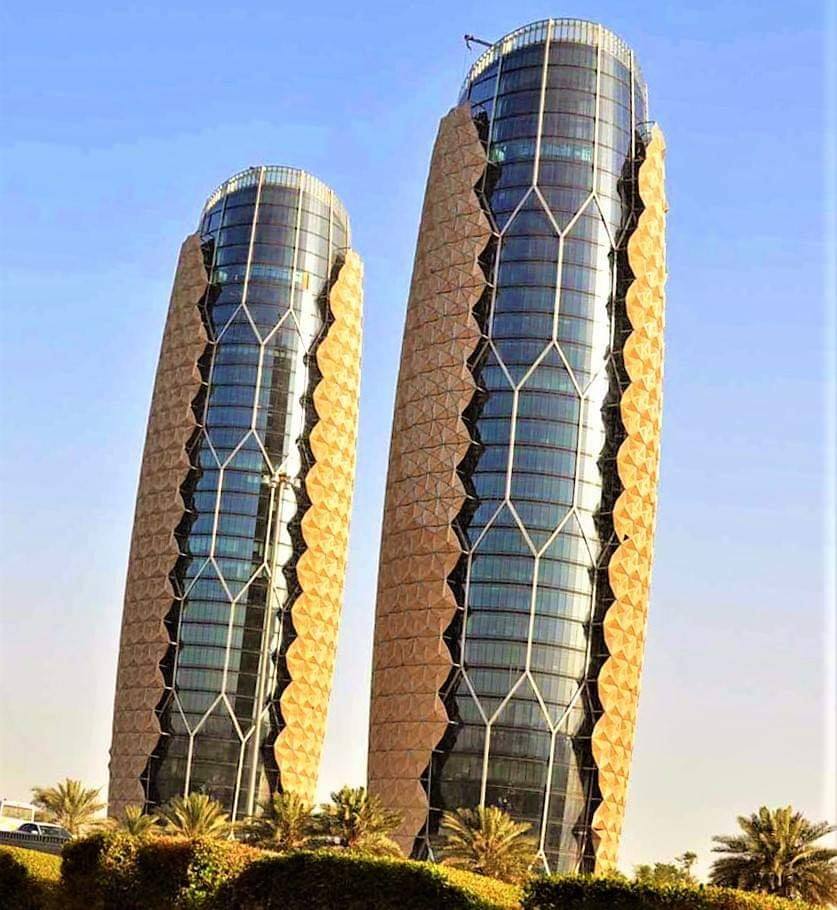
This innovative façade is automatically responsive to the sun, with triangular panels that open or close depending on the sun’s position. This dynamic shading system significantly reduces heat entering the buildings thus minimizing air conditioning needs resulting in great energy savings. The outcome is not just an architectural beauty but also a very effective and sustainable solution aligned to Abu Dhabi’s green building policy.
2. Al Raha
Al Raha’s circular construction also creates an outstanding Abu Dhabi monument. Whether you refer to it as the coin, the cookie, the smartie, it is the first-ever spherical construction in the United Arab Emirates. Designed by MZ Architects, the 110-metre tall structure is Aldar’s headquarters and Emporis has rated it among the World’s Most Dazzling Corporate Offices.
The building has water systems and efficient lighting along with a district cooling plant. Its ground-breaking subsurface automatic vacuum-waste collecting system recycles and reuses every waste product in the building.
3. Burj Mohamed Bin Rashid Complex
Thanks to its sloped roof, the tallest skyscraper in Abu Dhabi seems like the top has been chopped off. Rising higher than the Abu Dhabi World Trade Centre Mall, the 92-floor Burj Mohammed Bin Rashid complex incorporates both residential and business areas. Adding solar collectors and a ventilated three-skin façade, ChapmanBDSP planned the construction to be energy efficient.
The Burj Mohammed Bin Rashid Complex is a perfect model of mixed-use development, integrating residential, commercial and leisure spaces within a single, vertically-oriented structure. The tower offers luxurious residential apartments that provide residents with panoramic views of the city and the Arabain Gulf. These high-end living spaces are complemented by state-of-the-art amenities such as fitness centers, swimming pools, and recreational areas making it possible for its inhabitants to live premium lifestyles.
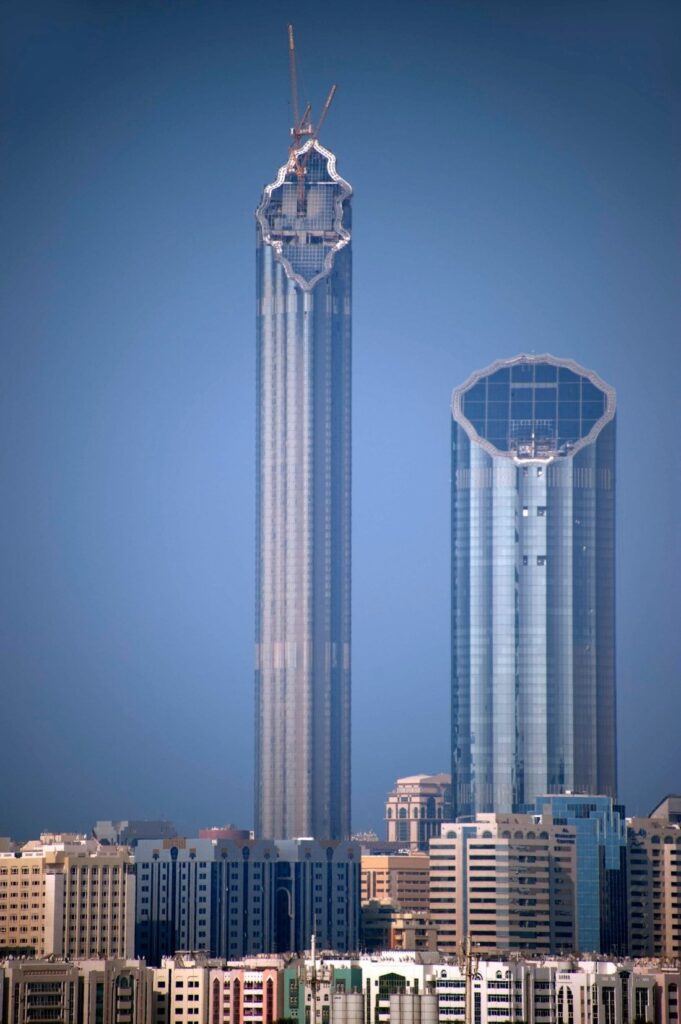
4. Capital Gate Building
The Capital Gate Building, sometimes known as Leaning Tower of Abu Dhabi, in Al Rawdah. Designed by architectural company RMJM. With an inclination of 18 degrees (that is, 14 degrees more than the Leaning Tower of Pisa in Italy) the 35-story high edifice practically stands straight by absorbing and channelling the pressures produced by wind and earthquake loading.
Capital Gate Building has a foundation that is yet another engineering marvel. The tower is anchored well to the ground using a deep, reinforced concrete base. This foundation is specifically designed to counterbalance the inclination of the building through a method known as pre-cambering, in which the center part of the structure was built to bend slightly in an opposite manner compared to its final tilt.
Not only is Capital Gate Building an architectural miracle but also it symbolizes Abu Dhabi’s ambition and commitment in advancing modern architecture. It is very distinctive because of its sleek twisting form and dramatic lean, which makes it stand out in the city with numerous people marveling at its attractiveness from all over the world.
Within the Capital Gate Building are luxury office spaces, retail areas and five-star Andaz Capital Gate Hotel located on the upper floors of the tower. This unique position of the hotel within this sloping tower gives visitors breathtaking sights of the city and its landscape thus serving as part of its magnetic appeal.
5. Mandarin Oriental Abu Dhabi’s Emirates Palace
One of the key architectural Abu Dhabi landmarks is a hotel, which seems odd given the city full of ultra-luxe residences is almost to be anticipated. Among such features is the Mandarin Oriental Abu Dhabi’s Emirates Palace. With a main building spanning one kilometre in length and 114 domes as well as a sizable centre dome hanging over 70 meters above the ground, the Arabian-style fantasy castle is among the most amazing sites to view in the city.
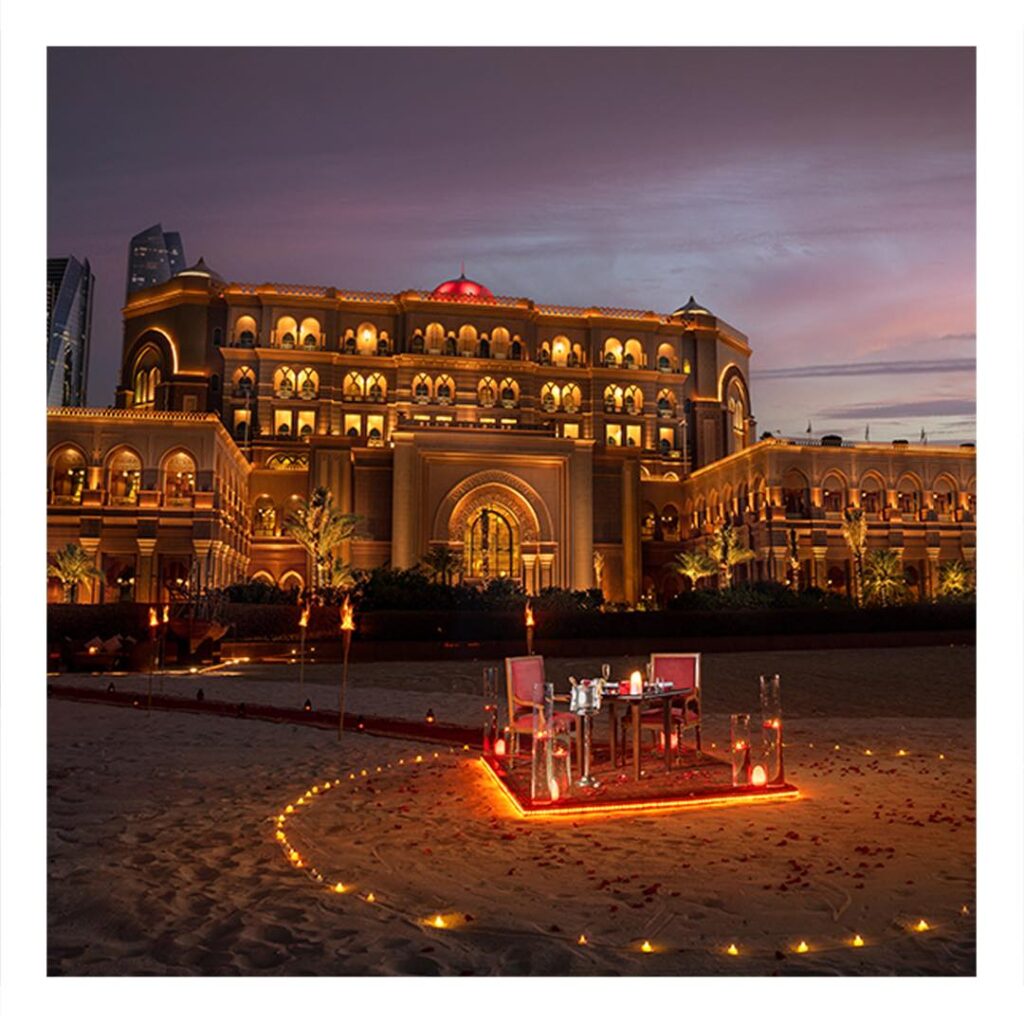
This Palace of Emirates is well-designed in all its details just like its intricate domes. In fact, the main dome is nothing less than a masterpiece with its elaborated patterns, gilded surfaces and ornate detailing reminiscent of the heydays of Arabian architecture. It also has a fantastic interior just as inspiring with large open spaces, lavish furnishings and artistically decorated walls that give it an air of grandiosity or richness.
Gourmet chefs from all over prepare food for guests at various fine dining venues in this hotel. The Emirates Palace encompasses everything from extravagant ballrooms to tranquil beaches so you can be sure that your stay there will remain etched in your memory forever. Furthermore, this palace is an integral part of Abu Dhabi’s culture whose architecture and design portray the city’s rich history and customs.
There are traditional Arabian motifs alongside modern luxury technologies which create a unique combination that embodies the spirit of both yesterday and today. Designed by WATG Architects, the construction combines Islamic architectural ideas like proportion, geometry, and balance.
6. Etihad Tower
Comprising five glistening towers, Etihad Towers is a famous landmark in the city and rapidly became a familiar sight on the skyline. Though the towers range in height from 54 to 74 stories, the second tower’s 74th level must be the most often used one. Here you will find an Observation Deck and a café with the best city view point.
Etihad Towers represents not just a piece of significant architecture but also a focal point for social and cultural events in Abu Dhabi. Businessmen and art lovers alike regularly flock to its events, exhibitions as well as other gatherings. In addition, there are luxury retail shops and fine dining restaurants located in the podium.
More than just a vantage point for viewing; the Observation Deck features many café services, where guests can savor light snacks like afternoon tea while admiring breathtaking views. Therefore, it becomes vital for both visitors and citizens who would want an extraordinary moment to sip their drinks observing this city’s landmarks from up high.
Each of its five towers is uniquely designed but shares one podium that includes high-end shops, dining spots and recreational facilities among others. This mix of several functions such as apartments for residence, offices and hotels makes Etihad Towers a single dwelling place where one can reside work or enjoy life without leaving the premises.
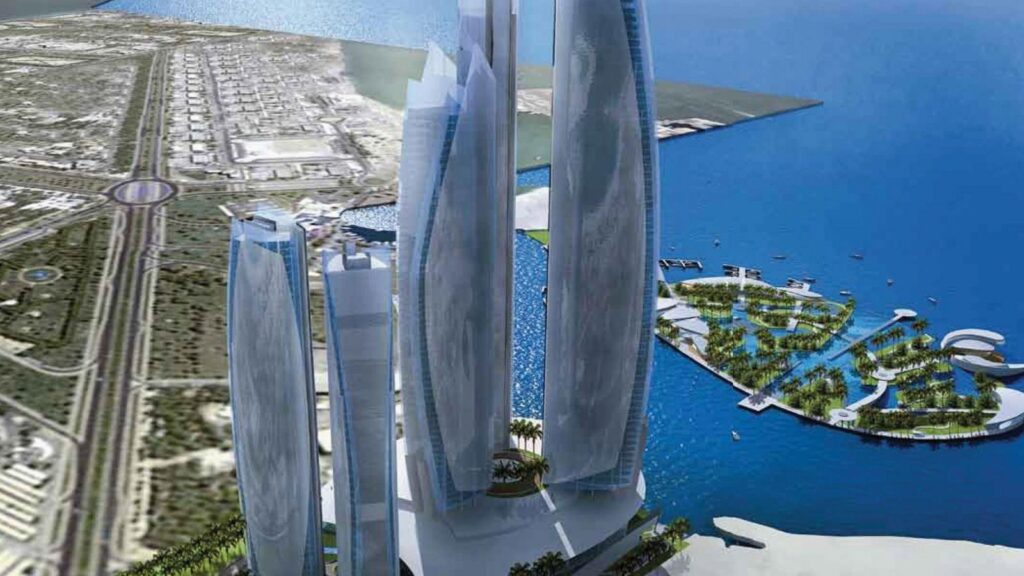
Breathtaking Natural Beauties Abu Dhabi
1. Al Mirayr
Just a stone’s stroll from the lovely Qasr Al Sarab Desert Resort by Anantara, you will encounter the striking sight of Al Mirayr, a desert woodland. Though its contrast with the saffron-hued desert sands around it makes it unlikely to be the biggest woodland area you will have clapped eyes on, it could just be one of the most beautiful.
To get there, you will need a 4WD enabled car; if you would want to continue the wadi walking, the surrounding dunes has many more fascinating Abu Dhabi bucket list locations to see.
Al Mirayr isn’t simply a destination; it’s really a gateway for more explorations. There are numerous interesting venues near the dunes, which allow one to continue the adventure beyond this point. The woodland here is worth seeing not only as evidence of how much strength there can be in almost uninhabitable spots; but also because it provides people with rare possibilities that have been running against the tide of life for generations.
2. Oasis al Ain
Found in Al Ain, this 1,200-hectare desert oasis became UNESCO World Heritage site in 2011. More than 147,000 date palms, trees bearing mangos, oranges, bananas, figs, and jujube abound there. Under fractal canopies, its quirky shaded paths create a startling contrast to the urban jungle of Abu Dhabi. Along with a look back at the oasis’s past, there is an Eco-Centre providing information on its conservation initiatives.
The shaded paths of Oasis Al Ain are a delight to explore, offering a cool respite from the desert heat. When wandering under palm frond fractals, one may find themselves lost in an environment so serene that it feels like a different world than busy Abu Dhabi’s urban cityscape. The passageways are taken through thick green walls that create labyrinthine features leading one into the calm corners of this oasis where everything appears to slow down due to its quietness.
For viewed contrasts which exist between the exceedingly green oasis and encircling dry land and also metropolis jungle areas of Abu Dhabi mark Oasis Al Ain as an exclusive destination because it is little-known destination that has got much history and nature together with culture due to its environment being calm and amazing at once; hence one can discover much about the UAE while enjoying a peaceful atmosphere full of respect for antiquity.
Therefore, Oasis Al Ain serves as a journey through time amid nature’s persistence among fragments of ages-long stories behind every tree, stone or drop of water available in this city’s oasis’s stillness. Understandably, people visit it not only because they need a peaceful place but also to be part of place where life’s spirit has kept on living for centuries.
3. Al Wathba Fossils Dunes
Though few can match the beauty of Al Wathba’s fossil dunes, the UAE’s desert landscapes are full with wonders. Made over the previous 120,000 years, these naturally occurring monoliths protruding, jagged relics of the emirate’s legendary geological past. Found a short distance from the Al Wathba Wildlife Reserve, an area comprising more than 1,700 of the fossil dunes has now been named as a protected landmark.
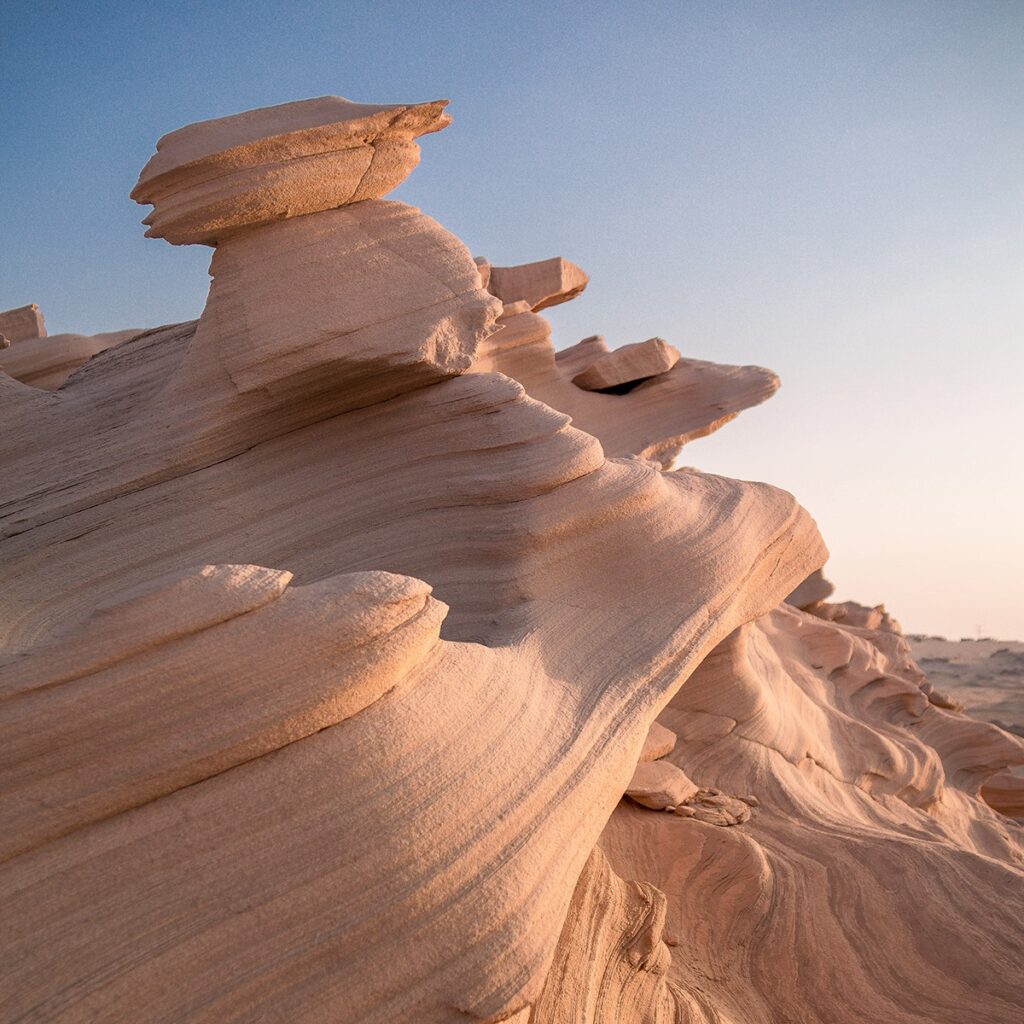
The Al Wathba Fossil Dune Protected Area presently boasts of a visitor centre, a viewing area, an amphitheatre, 7kms of hike-able paths with instructional signs outlining the origins and cultural value of these amazing sand relics.
4. Wathba Wetland Reserve
Popular resting place for flamingos in autumn and spring, this note-worthy location is located next to the exquisite Al Wathba fossil dunes. Known as Flamingo City, it boasts freshwater and saltwater lakes as among its several wildlife habitats. Along with a great abundance of marine life, the area boasts over 250 bird species and 37 plant species.
Popular for bird viewing, the marsh also has two self-guided walking paths for area exploration. Since the walking paths are very long, be careful to pack in your reusable water bottles to maintain the environment as natural as possible without cafes.
5. Jebels Hafit
About 90 minutes’ drive from the capital city, Jebel Hafit, Abu Dhabi’s highest mountain which is part of a UNESCO World Heritage Site, is situated in Al Ain. For those who like to bring their own canvas and poles, there is a campground with tented lodging and pitches. You may also hire classic Bedouin-inspired tents, bubble tents with panoramic windows ideal for star-gazing and luxury dome tents with AC, a TV, and a telescope.
Holiday-makers come here to hike, mountain bike (rental available), dune buggy, ride horses and camels and appreciate the rare fresh air that supports the ideal circumstances for stargazing.
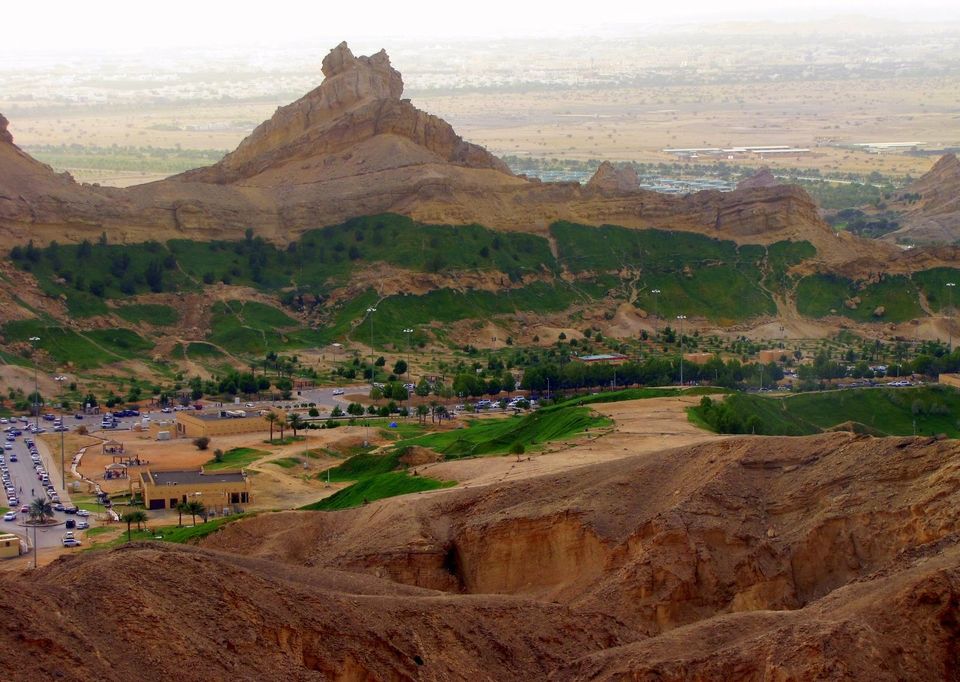
6. Beehive Tombs
This ancient tombs represents the start of the Middle Eastern Bronze Age. Here were discovered evidence of pottery vessels and copper artefacts as well as 5,000-year-old buildings, suggesting the significance of marine trade even then across the Arabian Gulf. On a mountain bike, horse, or camel, you can see the magnificent natural surrounds of the park. Explore historical and archaeological sites revealing the ancient way of life of this special region.
Jebel Hafit’s rocky terrain and beautiful sceneries make it an ideal destination for those who want to engage in outdoor adventure while taking a voyage into history. Visitors can ride on horseback, mountain bike or camel through the trails of the park and take in the breathtaking natural surroundings. This is a harsh but appealing area whose history is accompanied by historic and archaeological sites that hold on to the lifestyles of ancient people.
Visiting Beehive Tombs at Jebel Hafit is not just going to an archaeological site but digging deep into the origins of civilizations from Middle East’. These graves have been there all through time and they are silent witnesses to lives lived, deaths occurred and beliefs once held by ancestors. Hence it becomes a fascinating location for history lovers, explorers and others who want to connect with Arabian Peninsula’s most distant past due to its natural beauty together with historical importance attached to tombs themselves.
7. Jubail Mangrove Park
Opening in January 2020, Jubail Mangrove Park gives guests the chance to discover one of the most amazing natural habitats in this area. Located on a peaceful outcrop of Jubail Island, the mangroves were immediately popular among both inhabitants and visitors. It’s located about 20 minutes’ drive from Downtown Abu Dhabi and has a meandering 2.3km boardwalk.
Along with other more enigmatic species, the park also houses herons, flamingos, turtles, gazelle, crabs. The well-being of the coastal ecosystems largely hinges on Mangrove forests. They serve as natural buffers against storm surges, protect shorelines against erosion and provide important breeding areas for marine life. In addition to these ecological functions mangroves play an important role in carbon sequestration through which a great amount of carbon dioxide from the atmosphere is absorbed helping mitgate climate change effects.
Jubail Mangrove Park is not only a site for recreation but also an informative place. This park’s layout promotes visitors’ learning about the ecological significance of mangroves together with their protection efforts in conserving such crucial environments. Informative signage on the boardwalks and guided tours provide an opportunity for understanding cycles in mangrove life as well as the wildlife depending on them, thus increasing knowledge and admiration for this rare environment.
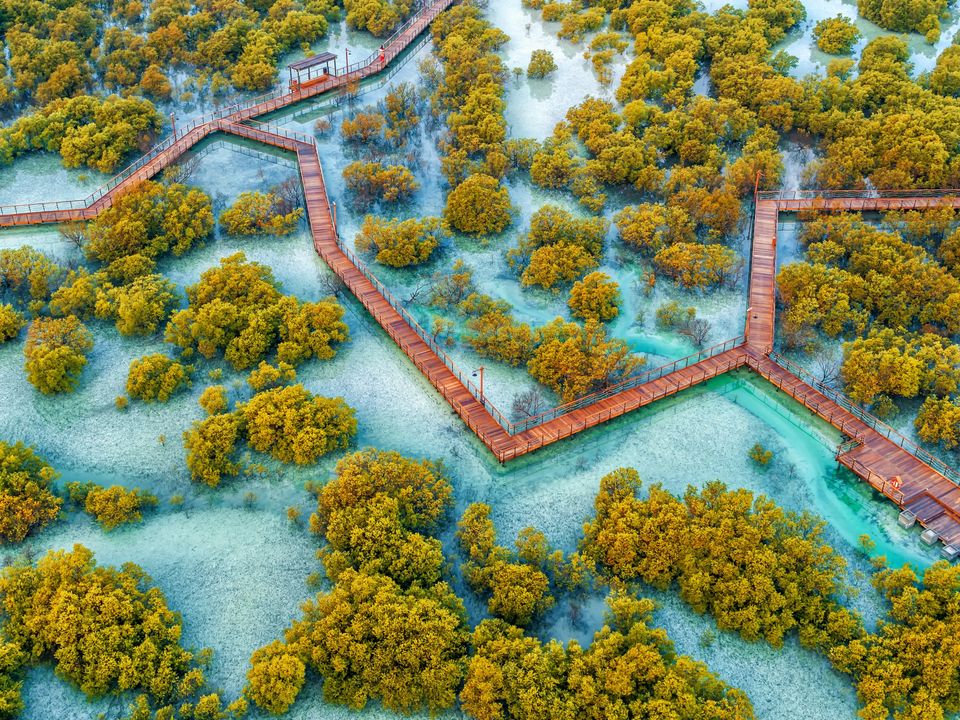
8. Liwa Oasis
Liwa Oasis, the ancient home of the Nahyan family and the Bani Yas tribe, is located at the northern tip of Rub’ Al Khali, the Empty Quarter. The 100km Liwa Oasis area is a stretch of desert where the dark green of date trees stands out sharply against the amber desert sands.
There are walled sections, rebuilt forts and watch towers, and a collection of absolutely massive dunes like Tal More’s eb, at 300 meters high, among others.
9. Plant Lake
Found near Zeera Island and across the water from Khor Laffan, at the eastern side of Al Jubail Island, this fluvial feature among the mangroves was given the name “Plant Lake” by the a mangrove photographer from Abu Dhabi.
Herons, egrets, and other landing birds that dwell on the shores of the lake can easily be seen there by bird watchers. Also, the surrounding mangroves have been home to a myriad of aquatic creatures, including little fishes and decapods which are integral parts of the ecosystem. However, all of this stuff is simply not enough to admire about since Plant Lake forms a significant component of Fluvial systems responsible for keeping Al Jubail Island mangroves alive.
An influx and outflow route is formed by this lake across adjacent mangrove forests contributing freshwater into them. This hence restores an equilibrium required for supporting all sorts of life depending on such wetlands as mangroves helps in establishing diversity among plants and animals therein. A mirror image casts itself across plant lakes tranquil waters with its sky reflected in it alongside greeneries creating illusions that foster calmness as well as seclusion.
Besides being significant ecological elements of the whole mangrove system this hidden jewel serves as a peaceful place where people go to touch base with nature.
10. Sir Bani Yas Island
One of the nicest and most attractive locations in the emirate to enjoy the coastal views and to engage in different exciting activities is Sir Bani Yas Island. Perfect for a great beach day, the island boasts of several beautiful beaches and private resorts with first-rate amenities.
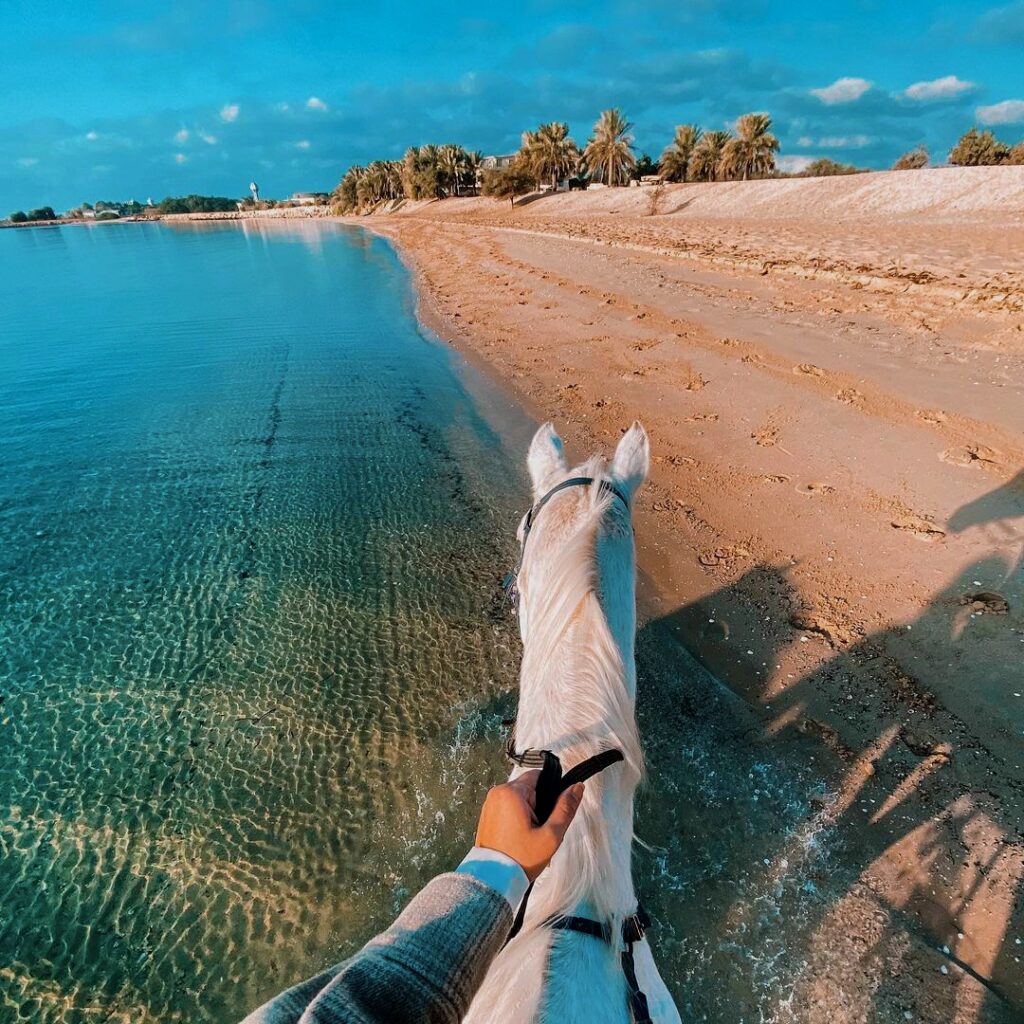
Although the setting is a private resort, one may find hawksbill turtles building their nest on the protected beach area and dolphins swimming in the neighbouring seas. Apart from this snorkelling, scuba diving, pearl diving, and kayaking across a mangrove forest, should be in one’s to-do list for a more fun and breathtaking visit to this island includes
Apart from the immaculate coastline, Sir Bani Yas Island boasts the Arabian Wildlife Park, a haven for endangered oryxes, gazelles, cheetahs, ostriches, and giraffes. As you explore the area on horseback riding, mountain biking, or a guided 4×4 excursion, you will not be shocked when you see these animals free-roaming in the dunes or within the park.
Fun Recreational Activities To Do In Abu Dhabi
1. Desert Safari Day Tour
For the daring souls among us, Abu Dhabi presents numerous guided desert safari excursions with their own distinct approach. Riding along the sand dunes on a camel, soar down them on a sandboard, or enjoy the ride in the luxury of a Jeep 4×4; some trips even incorporate more than one of these pursuits for the best bang for your money.
2. Visit The Abu Dhabi History Museum and Aquarium
The Abu Dhabi History Museum and Aquarium presents the rich history of the capital city from its beginnings in traditional desert life to the vast ultra-modern metropolis that is today using grand diorama-style exhibits. So this unique museum experience is far more than just reading old placards.
You would be right in the midst of a crowded market in one instance with merchants and traders offering their goods to each other while moments later you can find yourself on a sandy beach observing an antique craft or getting pearls from the ocean depths. The displays combine artistic inventiveness and accuracy from many historical periods so visitors are inspired and informed at the same time.

Abu Dhabi History Museum and Aquarium showcases Abu Dhabi’s heritage through visually splendid dioramas reliving scenes from various periods. This way, visitors are able to move back into time experiencing how each piece contributed to the development of this great town as well as experiencing its transformation closely at every stage.
3. Catch The Marina Eye Ferris Wheel
The Marina Eye, which soars an amazing 820 feet in the air, is the tallest Ferris wheel in the world. As you would imagine, the massive, record-breaking construction on Bluewaters Island provides guests with unmatched aerial views of the city’s grandiples.
Open seven days a week, the observation wheel boasts 42 regular capsules as well as several opulent VIP capsules for the actual “high roller”.
4. At Ferrari World Abu Dhabi, Ride The Fastest Roller Coaster On Earth
Now at Ferrari World, the first Ferrari-themed amusement park worldwide, everyone can experience the excitement of luxury sports cars! Apart from flaunting its luxury vehicles, it is among the biggest indoor theme parks in the world with a vast range of rides and attractions for guests of all ages dispersed over an amazing 925,000 square feet!
Motorsport and Ferrari’s grand history is what this park is all about. Brand’s past can be explored by the visitors through interactive displays, racing simulators that challenges their driving skills, along with virtual reality such as what racing will be like in future years. Speed isn’t the only thing found there; it also belongs to opulence and advancement.
The park has a selection of some of the most emblematic cars made by Ferrari, providing an opportunity for people to appreciate them at close range as works of art in transportation sector. There is remarkable attention given to every visualization aspect in the park; for instance, sleek contemporary structures on one hand or reproduction of all Ferrari’s aesthetics within every attraction on another hand.
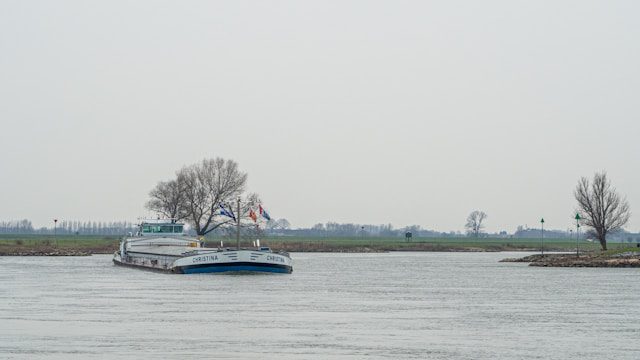
Ferrari World Abu Dhabi is not just about fast cars and thrilling rides but also a kid-friendly destination where families can stay together. Among children-friendly playing areas include Junior GT where kids drive reduced-size vehicles designed as Ferraris or Flying Aces, an exciting roller coaster experience.
5. Book A Sightseeing Boat Trip In Abu Dhabi
From cruises and speedboats, which is a must for every thrill-seeker out there, there are many choices available. Under the direction of a pleasant captain and tour guide, you will rush down the coast pausing for picture ops at key tourist sites.
Expect your guide to provide facts about Heritage Village, Lulu Island, and amazing Emirates Palace while the breeze blows across your face and to fully capture all the elements of the stunning 21st-century skyline. Luckily you might even find a pod of dolphins!
6. Take A Hop-On Hop-Off Bus Trip Around Abu Dhabi
Time short? Not bothered enough to create an tour plan? Here is what you can do: get on or off a double-decker bus to tour the whole city at your own speed, visiting every main Abu Dhabi tourist attractions!
With one, two, or even five day tour bus passes, you can let someone else drive and spend as much time as you wish at the Grand Mosque, the seafront Corniche, the Founder’s Memorial, Emirates Palace, and many of the other famous sites.
7. Walk Around Yas Marina Circuit
For motorsports enthusiasts, the Yas Marina Circuit (home of the Abu Dhabi Grand Prix) offers a singular experience. Just 10 minutes from the airport, on Yas Island, guests may tour the circuit, enjoy go-karting, or even drive a race car on the course. The site is also a hive for sports aficionados since it organises community events and fitness activities.
Every motorsport lover should visit Yas Marina Circuit. Drivers around the globe contend against the tracks of this 5.5-kilometer race course which is a modern technological achievement. The guests can visit guided tours where they are allowed to most places that are mostly kept for racing stars only. One can see teams as they make adjustments in pit garages or even at the media center during these tours and get to know what goes on behind the curtains in Formula One racing.
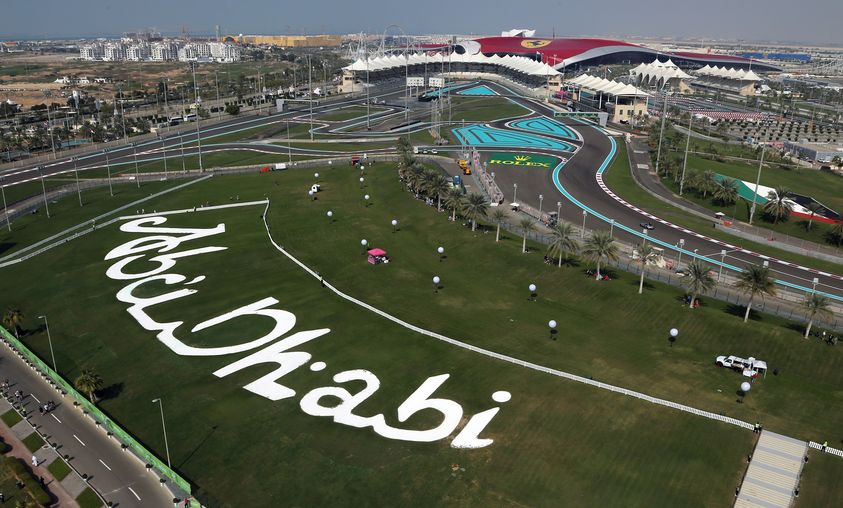
For one who wants to drive themself, there is good karting available at Yas Kartzone located in Yas Marina Circuit. No matter how experienced you are as a driver, karting here will be enjoyable . This 1.2-kilometer-long track provides an insight about handling racing machines with its sharp curves and fast straight parts on which drivers can test their abilities against each other.
For the ultimate motorsport experience, Yas Marina Circuit offers visitors the chance to drive a race car on the same track used by Formula 1 legends: with the Yas Racing Experience, you can get behind the wheel of high-performance vehicles like Aston Martin GT4, Ferrari 458 Challenge or even single-seater Formula Yas 3000 unleashing your inner racer within.
8. Explore Yas Waterworld
Families and adventure enthusiasts will find an exciting day at this water park. From leisurely rivers and wave pools to adrenaline-pounding Abu Dhabi tourist attractions like Dawwama and Bubble’s Barrel, Yas Waterworld suits all ages and intensity levels.
Bubble’s Barrel is another key feature of this location with a world record set for biggest surfable sheet wave. It caters for lovers of surfing very well as they can ride on wave heights of up to three metres. Regardless of your surfing experience, riding on Bubble’s Barrel is a daunting and yet rewarding endeavor that keeps you coming back for more.
Temperature controlled pools allow you to have an enjoyable time year round in Yas Waterworld, as well as shaded areas that always assure comfort during any season. There is also variety of food options available within the park such as fast food outlets and restaurants where visitors can buy snacks or meals depending on their choice so they do not have to leave if they want sustenance while enjoying themselves.
Things To know Before Visiting Abu Dhabi (Tips For Visiting Abu Dhabi)
1. Cigarette And Alcohol Use
Although smoking is forbidden in public spaces, several establishments have smoking rooms. Given the rising number of smokers, particularly among those between the ages of 12 and 16, the city’s Health Minister has instituted tougher rules pertaining to smoking in public places. The Health Authority of Abu Dhabi forbids advertising and marketing of tobacco as well as consumption.
Alcohol is sold in licensed restaurants and bars in Abu Dhabi; drinking alcohol in unapproved venues (like a public beach) is against the law. Although having a good time is quite reasonable, after one too many there is no tolerance for wild, noisy, violent behaviour. Therefore, it is forbidden and punished by fines and jail to swear, act rudely, pick arguments or cause public disturbance.
2. Security
Considered as a rather safe city, Abu Dhabi boasts a very low crime rate. The City police keeps strict control over security and safety concerns even if the crime rate is almost zero. Consequently, it now boasts among the lowest crime rates among cities worldwide. Although exploring the city at any hour is always safe, it is advisable to follow some fundamental safety guidelines.
Travelling at night is safe; there is no need to be unduly worried about security when using public transport. Still, as we would often do while outside, it is advisable to follow basic safety measures.

3. Best Time To Visit
This city is in a sub-tropical climate, so typically hot and warm temperatures all year round. Sand, seawater surfing is well known from the year-round brilliant, clear sunlight. Staying indoors is advised especially during the mid-day as the summer season is somewhat hot with quite high temperatures. Hotels provide a wide spectrum of indoor activities and completely air-conditioned facilities so that guests may unwind and enjoy their trips.
November to February is the ideal time to travel since numerous celebrations take place there and there are many fantastic outdoor activities to engage in amid rather low temps.
4. Dress Codes
This city has a flexible dress code unlike many Arab cities. Summertime lightweight attire is usually allowed. Although this city is well-known summer Abu Dhabi vacation spots, one should pack warm clothing for the quite low evening temperatures. While swimsuits or short clothing are permissible on beaches, the inappropriate dressing should be avoided in public places.
Summertime breathable materials like cotton and linen help one better tolerate heat and humidity.
5. City Travel
There are four main ways to get about the city: taxi, bus, tour, rental automobiles or private vehicles. Along with other things, Abu Dhabi international airport features well-developed amenities including boutiques, stores, and a golf course. The architecture of the airport is especially appealing to visitors and has evolved into a symbol to boost the travel business in the city.
The city boasts a decent road system, and barely any significant traffic congestion problems even during peak hours. There is modern bus service around all important locations for twenty-four hours. Another less expensive way to tour the city is by taxi or auto rental, which are conveniently placed all around.
Eight routes around the city and sites including the Louvre Abu Dhabi, Qasr Al Hosn, Qasr Al Watan and Sheikh Zayed Grand Mosque are linked by the complimentary Experience Abu Dhabi Shuttle Bus. Wheelchair-accessible and a great means of seeing Abu Dhabi Island, Saadiyat Island, and Yas Island are these modern air-conditioned buses.
Purchase the prepaid Hafilat Smart Card at the Abu Dhabi Central Bus Station or any branch of the Lulu Hypermarket to use on public buses in Abu Dhabi and Al Ain. Load funds onto it via bus station recharge machines. Scan in and out on the validator in the buses to pay.
6. Public Show Of Affection Is Not Encouraged
Public displays of affection including kissing and hugging are frowned upon and forbidden at places of worship including the Sheikh Zayed Grand Mosque. These days, holding hands does not draw attention, but exercise your judgement based on the situation. In a shopping mall or at the beach, this is most likely OK; but, not at the Abrahamic Family House or the seafood market. In Abu Dhabi, same-sex relationships are against the law.

7. Don’t Drink And Drive
In the United Arab Emirates, driving under the influence of alcohol is illegal and may land you fines and jail time should it lead to an accident or you are caught. If you intend to drink, leave the rented automobile behind and hail a taxi.
Frequently Asked Questions
1. Which Part Of Abu Dhabi Is Best?
Abu Dhabi’s best places to to visit includes:
- The island Saadiyat.
- The island Al Reem.
- Al Rahae.
- TheCorniche.
- Al Rio.
- Khalidious.
- Island Al Maryah.
- Al Zahiyah and Al Markazowicz.
2. What Is The Most Famous Thing In Abu Dhabi?
Abu Dhabi has the Sheikh Zayed Grand Mosque, which is perhaps the city’s most recognizable and beautiful building, as well as one among biggest mosques around the globe. In 2007 it was completed while its name was derived from Sheikh Zayed bin Sultan Al Nahyan—the man who imagined this place as a mark of harmony and tranquility—who also happened to be the founder and first president of United Arab Emirates.
3. What is Abu Dhabi Special For?
Like several United Arab Emirates, Abu Dhabi boasts a rich pearl diving legacy. Actually, in 2019 archaeologists on Marawah Island in Abu Dhabi found the oldest known pearl on Earth. The Abu Dhabi Pearl first appears between 5,800 and 5,600 BCE.

4. How To Enjoy Abu Dhabi?
Abu Dhabi’s iconic landmarks should be your first stop if you want to experience all it has to offer. One place worth visiting is Sheikh Zayed Grand Mosque—a beautiful building with its breathtaking white marble domes and elaborate Islamic art. You can also try luxurious afternoon tea at Emirates Palace, now known as Mandarin Oriental Abu Dhabi. For something more contemporary, head over to Etihad Towers (the best site to view the entire city) and ideally begin just near Corniche for scenic long walks along the waterfront.
Yas Island is also a perfect destination for adventures and amusements. Ferrari World has the fastest rollercoaster in the world; Yas Waterworld is an aquatic paradise while Yas Marina Circuit hosts some of the most thrilling motor races. However, you should balance this excitement with tranquility such as visiting Mangrove Forest Parks or rest on calm beaches. Finally, complete your trip by visiting Abu Dhabi History Museum and Aquarium where you will get immersed into rich heritage of this city.
5. What Makes The Residents Of Abu Dhabi Wealthy?
The rapid urbanization and development of the city of Abu Dhabi in addition to its enormous oil and gas reserves, production capacity and comparatively high average income have transformed it into one, great developed metropolitan area. It serves as a political and business center for this country; it is also recognized as one of major hub cities for culture and trade.
With its rich cultural heritage, sublime landscapes, interesting museums, contemporary architecture, vibrant food scene and kind-hearted people, Abu Dhabi is a delight.
Final Words
The city of Abu Dhabi serves is a perfect blend between cultural and technological progress. It boasts of a plethora of sites for all kinds of tourists from its deep-rooted traditions seen in places like Qasr Al Hosn to the adrenaline provoking rides at Ferrari World or Yas Marina Circuit among others.
For example, Abu Dhabi has awe-inspiring architecture, high-end shopping stores, as well as family entertainment venues giving it a strong appeal. Whether you are considering visiting ancient monuments or glamorous neighborhoods or just soaking up some sunshine on any beach, one thing is for sure: your trip will be filled with surprises and enjoyment forever.


